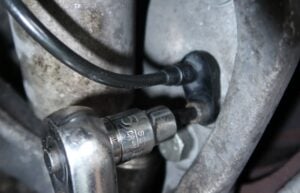Troubleshooting VW ABS Light On
Is the ABS light appearing on your Volkswagen dashboard? Learn how to troubleshoot what is causing it to illuminate and know the possible solutions to solve the problem by following the procedures below.
In this guide, we will discuss what it means when the Volkswagen ABS light stays on, common problems that trigger the VW ABS light, and how to troubleshoot it. The common problems that trigger VW ABS light are: a faulty ABS wheel speed sensor, steering angle sensor, failed ABS Control Module, or damaged wires.
The most common problem is ABS wheel speed sensors, which can get dirty over time or fail. When this happens, the sensor will need to be replaced to reset the ABS light. In some cases, you can clean the sensor. Sometimes cleaning works, but there are no guarantees.
What does it mean when the VW ABS light stays on?
Under normal operation, the Volkswagen ABS light turns on when you first turn on the ignition but turns off within five seconds after the engine starts. The ABS light stays off when the system functions properly, and the ABS control module detects no faulty codes.
If your VW ABS light comes on and stays on, the Anti-lock Brake System (ABS) has been disabled because the ABS has detected a problem.
What does this mean?
Let’s look at a simple example. During an emergency stop situation, you hit the brakes hard. Because the ABS light is on, the wheels may lock up, and the vehicle can skid.
If you have driven an older vehicle with no ABS, you most likely have experienced this situation at least once. Because the traction control and ESP (Electronic Stability Program) depend on the ABS to function properly, traction control and ESP lights usually come on.
Symptoms
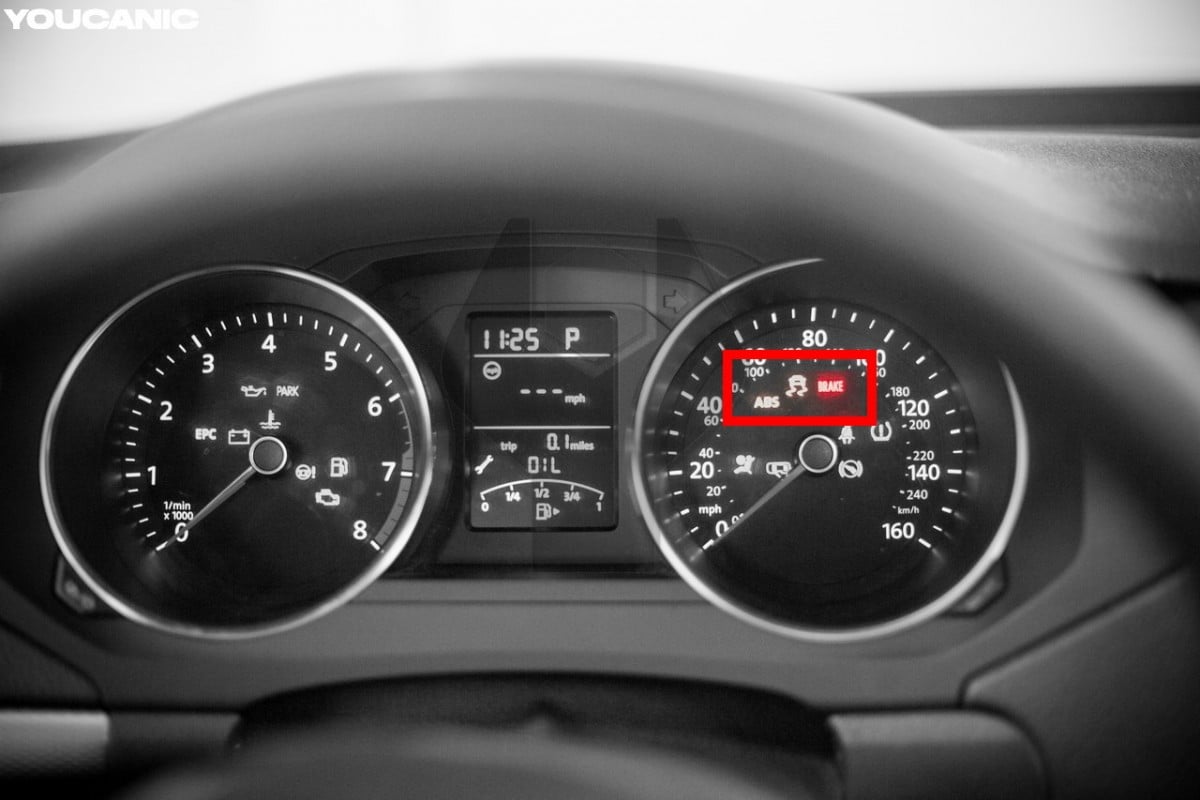
- ABS Light Stays On
- EPS and ABS Light Stay On
- Traction Control Light Stays On
- Red Brake Light Stays On
- VW brake light flashing and beeping
- The ABS light stays on, and the BRAKE light flashing
- The speedometer may stop working.
Common Problems

Common problems that trigger VW ABS light to come on are:
- Bad ABS wheel speed sensor,
- Faulty clock spring,
- Low battery voltage,
- Damaged wire harness,
- Dirty ABS wheel speed sensor,
- Bad brake light switch.
To find out why the ABS light is on, read the codes with a Volkswagen scanner via the diagnostic port underneath the dashboard on the driver’s side. Let’s take a look at how to diagnose VW ABS light.
How to Diagnose and Reset Volkswagen ABS Light
The first thing you should do if your VW ABS light comes on is to check the brake fluid level and add brake fluid if it is low. If the Volkswagen keeps losing brake fluid, you should get the vehicle inspected by a mechanic as soon as possible. Do not drive with the BRAKE light on. Your brakes may stop working while driving.
If the brake fluid level is ok, perform VW steering angle calibration. In most cases, this step can be performed without any tools.
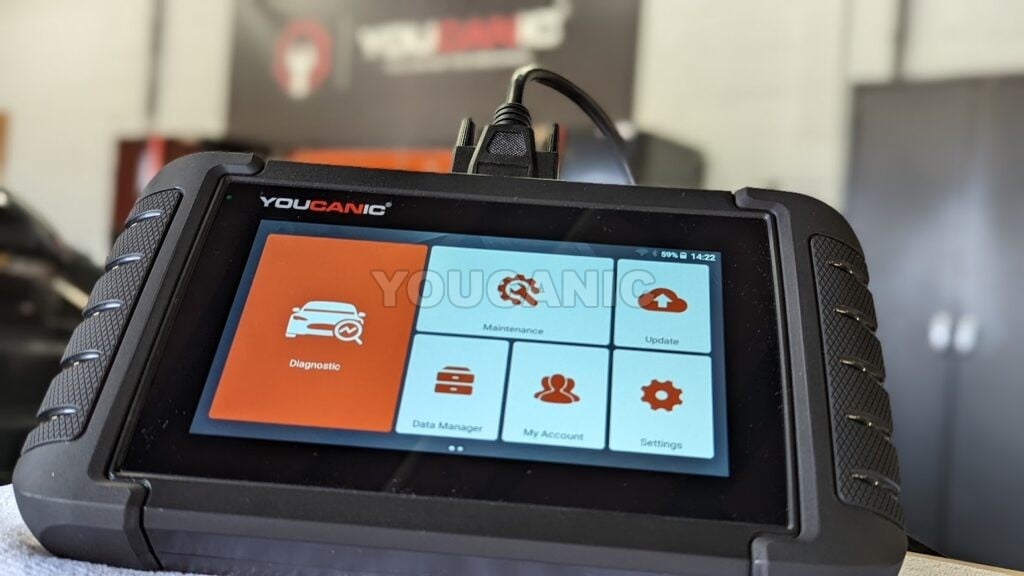
The YOUCANIC Full System Scanner can read and clear fault codes through every vehicle’s control module.
Troubleshooting the Volkswagen ABS light is fairly simple as long as you have the right tools. For this step, you will need a VW scanner that can read and clear codes from the ABS module and view live sensor data from the ABS module. We need to read codes from the ABS module. With a VW scanner that can read ABS codes, you’ll be able to narrow down the issue fairly quickly.
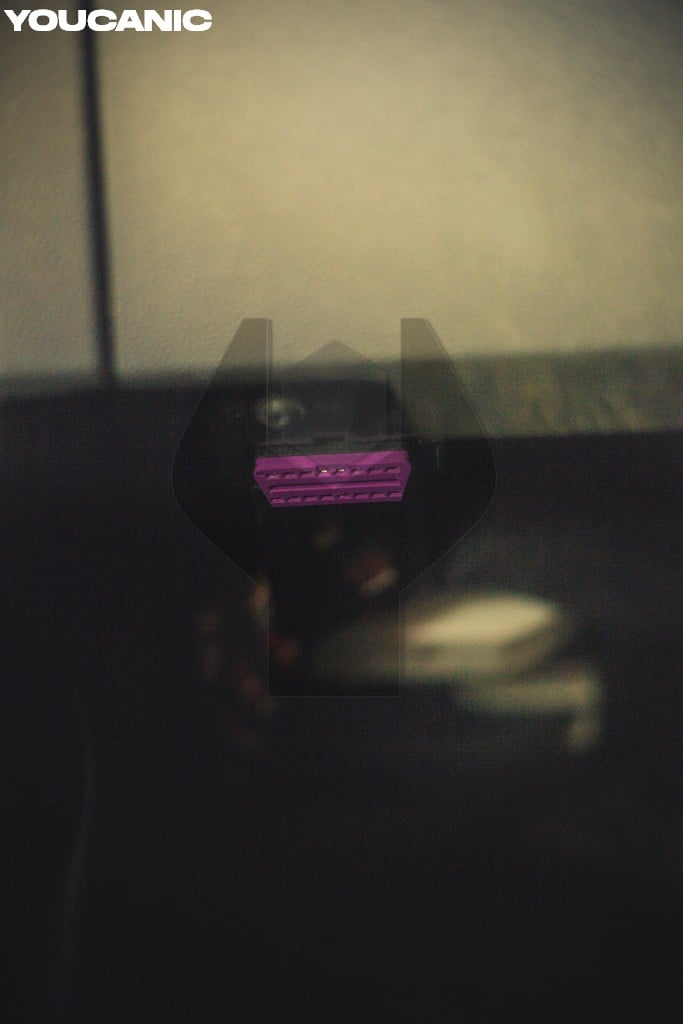
To troubleshoot the VW ABS problem, start by connecting an ABS scanner to the diagnostic port, power up the scanner, and go to the ABS or BRAKE module. Scroll down to the bottom to view live sensor data.
- Locate the diagnostic port underneath the dashboard—the driver’s side.
- Connect your VW scanner and turn on the ignition, but do not start the engine.
- Turn on your scanner, select Volkswagen, and then your particular model.
- Next, go to control units and select the ABS control unit or brake control unit, depending on the scanner.
- Scroll down to Read DTC or read fault codes. A list of fault codes will be displayed. You need to pay attention to codes that show as current or active. Those codes are the reason why the Volkswagen ABS is on.
- Next to the code, you will see a description of the problem or sensor that is faulty. For example, it will say, “Front right ABS speed sensor faulty.”
- Replace the faulty sensor and reconnect the scanner to clear the codes.
- Enter the ABS (Brake) control module again, but this time, instead of selecting read DTC, select clear codes and confirm by pressing yes.
You can also go under Live Data or Sensor Data, select ABS wheel speed sensors, and quickly display their values. Then, start moving the vehicle (have a helper drive while operating the scanner) and check the readings of the ABS wheel speed sensors.
You should start to see the revolutions of each wheel. If one of the sensors shows zero while the rest start to change, you know that that sensor is faulty, or the wires going to the sensor can be damaged or corroded.
Why can’t I clear my VW ABS light?
Ensure that you have an OBD-II scanner that can read Volkswagen ABS codes. Most generic and inexpensive OBD-II scanners cannot retrieve VW ABS fault codes from the ABS control unit or clear VW ABS light.
Read our article on OBD-II scanners if you need a good VW scanner.
Follow the steps above to read the fault codes from the ABS control module. Make sure that all fault codes have changed from ACTIVE to PASSIVE or STORED. You won’t clear the ABS light if you have an ACTIVE / PRESENT code.
You can clear VW ABS codes and reset the ABS light only if all the codes are shown as passive or stored. Go to the ABS Control Unit and select clear the ABS light; once you select clear DTC from the main menu, press okay on the confirmation screen.
If you have a faulty ABS wheel speed sensor and can’t clear the ABS light, inspect the wire harness to that sensor. Also, use a diagnostic scanner to reread the fault codes because you may have more than one faulty wheel speed sensor.,
Volkswagen ABS Problems Explained
ABS Wheel Speed Sensor
A faulty VW wheel speed sensor is one of the most common problems that cause Volkswagen’s ABS light to stay on. Replacing a faulty ABS wheel speed sensor is very simple and takes less than one hour. The only challenge is reading the codes with a VW scanner to determine which sensor is faulty.
We often see VW owners who replace all ABS wheel speed sensors when the ABS light stays on, hoping it will fix the problem. We do not recommend replacing random parts without first performing a diagnostic. While a bad ABS wheel speed sensor is often why your Volkswagen ABS light stays on, several other problems can trigger the ABS light.
A bad ABS pump, faulty ABS control module, blown fuse, steering angle sensor faulty or needs calibration, damaged wires, and even low battery voltage or dead battery can also be why your ABS light stays on.
ABS Control Module
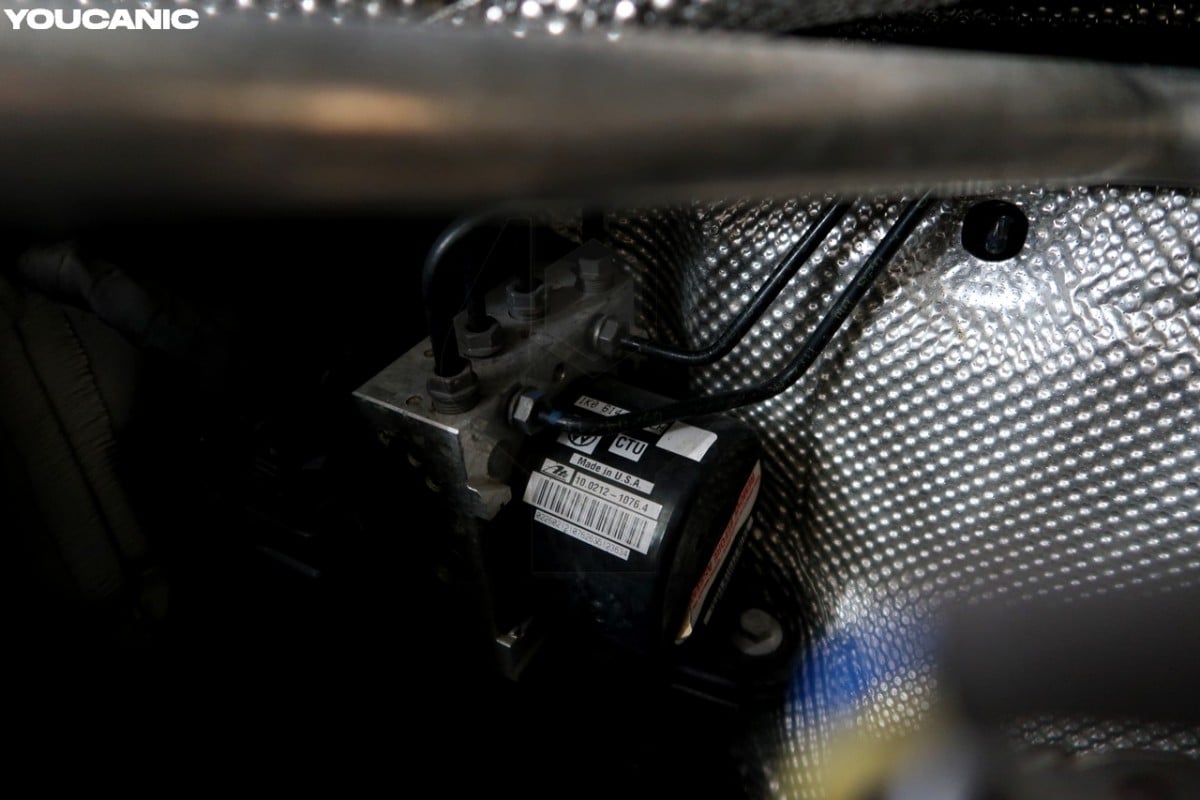
The ABS pump or module can fail and trigger the ABS, ESP, and traction control lights to come on. ABS pump failure can be severe and should be repaired immediately. Communication errors from all ABS wheel speed sensors or the inability to connect to the ABS module are common signs that the ABS module is faulty. A blown ABS fuse or a bad relay can also cause this.
VW dealers recommend that you replace the ABS pump, which can get very expensive. The average cost to replace a Volkswagen ABS control module is between $900 and $1,600. If you are looking for a less expensive solution, remove your old ABS pump and send it to a repair shop specializing in fixing VW ABS pumps on eBay. You can find many repair shops that offer this service on eBay.
A repair shop specializing in ABS repair will open your pump, find out what is wrong with it, and repair your old ABS pump. The downside of this method is that you will have to park the car for a few days while the ABS pump is repaired. Repairing the old ABS module can save you a significant amount of money. The average cost to repair a VW ABS Module is between $250 and $350, which is a lot less expensive than replacing the ABS module.
An added benefit of repairing your old ABS pump is that it will not need to carry any programming since you are installing the same ABS pump you removed. Fault codes may need to be read and cleared with a VW scanner.
Steering Angle Sensor
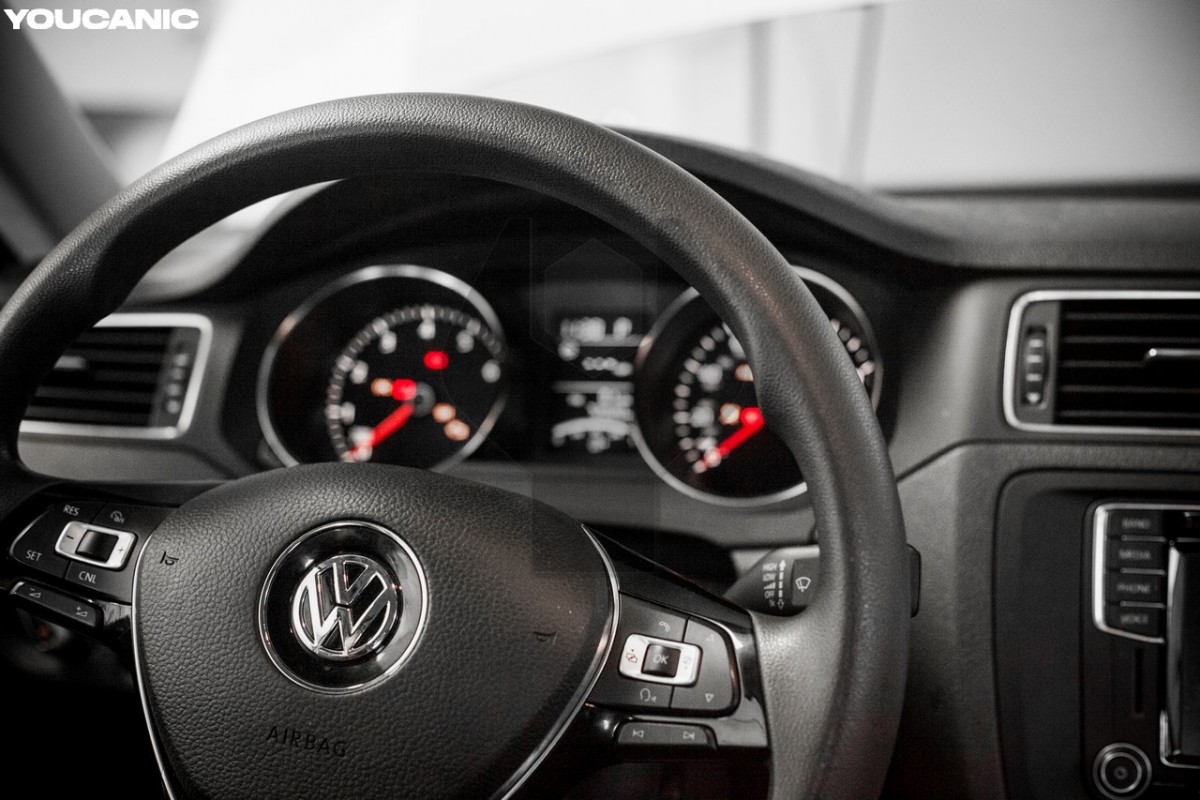
A steering angle sensor mounted on the steering column below the steering wheel can fail and may need to be replaced. Its purpose is to determine the direction the wheels are pointed by determining the steering wheel’s position as the driver turns it left and right. The sensor can fail and no longer detect if the steering wheel is turned.
The ABS module does not know where the driver is trying to steer. If the steering angle sensor does not provide input, the ABS light and traction and stability control (ESC, EPC) lights come on. The steering angle sensor may need to be reset. Follow this guide to learn how to reset the VW steering angle sensor.
Replacing the steering angle sensor is relatively easy but requires removing the airbag from the steering wheel.
Low Battery Voltage
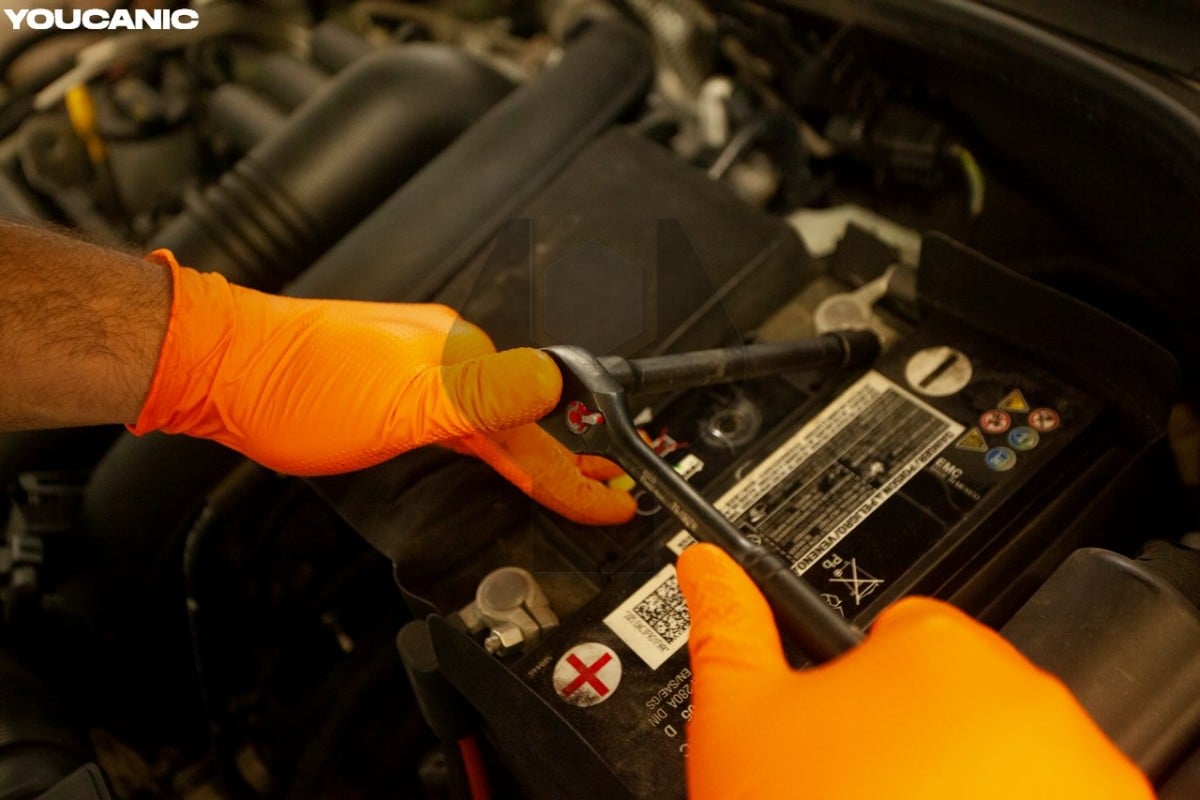
While older Volkswagen cars were not as sensitive to low voltage, a faulty code may be stored in the ABS control module if there is a weak battery, loose battery terminal, poor ground, or bad voltage regulator on a new Volkswagen.
In most cases, fixing the battery is all you need to do to reset the ABS light. When the voltage issue has been addressed, the Diagnostic Trouble Code (DTC) should automatically change from ACTIVE to PASSIVE.
If the problem is fixed, the ABS module realizes that and changes the PASSIVE or STORED code. This allows the ABS light to reset independently, and the fault code related to voltage will be stored in the ABS control module but will not be active.
Brake Light Flashing

Volkswagen ABS and brake lights may flash when there is a critical problem with the brake system, such as a too-low brake fluid level or a faulty ABS module. Do not drive if the brake light is on or flashes.
If needed, check the brake fluid level first and add the recommended brake fluid. Next, read the fault codes with an ABS scanner.
Damaged Wire Harness
While not a likely problem, the ABS control unit’s wire harness can be damaged and trigger the ABS light. A damaged wire harness typically causes several issues.
If your ABS light is on or your ABS pump is faulty, it is important to check if any open recalls related to the ABS exist for your vehicle. In the past, Volkswagen issued ABS module recalls. Check for open recalls here to determine if your VW is affected by an ABS recall.
Why is my VW ABS light on, but I get no codes?
If you use a generic scanner, it will only access check engine fault codes. It will not show ABS codes even when the ABS light is on.
Every Volkswagen has over twenty control units, including an engine control unit, transmission control unit, AC control unit, ABS control unit, airbag control unit, and many other modules. It is important to use a scanner that will at least read VW ABS fault codes.
If you have an ABS scanner but still don’t get any codes, you may have a bad ABS control module, a damaged wire harness, or a blown fuse.
Can I drive a VW with an ABS light on?
Driving with the ABS light on can be dangerous. It is unsafe and not recommended to drive with the ABS disabled, even if the brakes work. If the brake light is on in addition to the ABS light, stop immediately and have the vehicle repaired, as this can be a serious problem. The brakes will still function in most cases if there is a problem with the VW ABS. Bringing the vehicle to a complete stop, especially during emergencies, can take much longer without ABS.
Why do I need ABS?
Anti-lock braking allows you to maintain control of the car during sudden braking and to steer the vehicle even during braking.
If your ABS is not working and you are driving at 65mph and slam on the brakes, turning the steering wheel will affect whether the vehicle is sliding. On snow or ice, without ABS, you only have to go about 25mph before it’s impossible to steer during hard braking.
With ABS, you can steer and brake simultaneously. If you’re an experienced driver of non-ABS vehicles, you may be able to mitigate all of this considerably.
What are some common VW ABS codes?
Here is a list of common fault codes that often trigger VW ABS lights:
- 01130 / 1130 – ABS Operation: Implausible Signal. The fault code can be cleared after performing a Test Drive.
- 01276 / 1276 – ABS Hydraulic Pump (V64): Implausible Signal. Check for a blown fuse first before you replace the hydraulic pump.
- 00283 – ABS Wheel Speed Sensor Front Left (G47): Mechanical Malfunction.
- 16352 – Control Module Defective. 01276 – ABS Hydraulic Pump (V64)
- 00285 – ABS Wheel Speed Sensor Front Right (G45): Mechanical Malfunction.
Can ABS problems cause other problems?
The ABS module in your Volkswagen is designed to communicate with other modules. The ABS usually sets fault codes in other modules, such as traction control and stability control systems.
The data from the ABS module is likely useful to other control modules, and their proper interaction is absolutely necessary. Almost all 2000 and newer VW vehicles, such as Jetta, Passat, Golf, Tiguan, Routan, Eos, and Bettle, have ABS. This guide applies to all VW vehicles with ABS, including Jetta, Passat, Golf, Tiguan, Routan, Eos, Bettle, etc.
We hope you find the Troubleshooting VW ABS Light On guide helpful. Check these troubleshooting and repair guides for more help on your Volkswagen.





